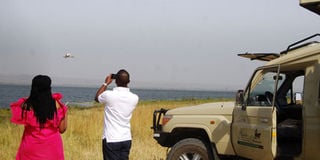Oil exploration in Murchison Falls will go on, Nema insists

Paradise in danger? Tourists at the Ramsar site inside Murchison National Park, where an oil well and the pipeline are to be established. PHOTO BY TOBBIAS JOLLY OWINY
What you need to know:
In April, Nema issued an approval certificate for the Tilenga oil project to Total E&P Uganda and Tullow Uganda Operations Pty Limited (TUOP) for the development of six oil fields with 34 well pads, an industrial area, pipelines and other supporting infrastructure.
The certificate of approval recently issued for Tilenga Project environmental and social impact assessment by government is a final document and cannot be revoked, the National Environmental Management Authority (Nema) has said.
Mr Tom Okurut, the Nema executive director, confirmed the development during a telephone interview with Saturday Monitor on Thursday while reacting to demands by civil society organisations (CSOs)for government to revoke the certificate and cause fresh public hearings.
Tilenga oil project within Murchison Falls National Park is estimated to last between 25-30 years.
Once production starts, an estimated 190,000 to 200,000 barrels of oil are expected to be produced per day.
The project to the north of Lake Albert will be undertaken by Total E&P and Tullow Uganda Operations Pty Limited.
Government in 2016 granted production licences for Ngiri, Jobi-Rii, Gunya fields and Mputa-Nzizi-Waraga, Kasemene-Wahrindi, Kigogole- Ngara, Nsoga and Ngege fields respectively.
By issuing the certificate, government allowed the developers to proceed with the activities.
In April, Nema issued an approval certificate for the Tilenga oil project to Total E&P Uganda and Tullow Uganda Operations Pty Limited (TUOP) for the development of six oil fields with 34 well pads, an industrial area, pipelines and other supporting infrastructure.
However, civil society organisations under their umbrella, Civil Society Coalition on Oil and Gas (CSCO) demand cancellation of the certificate, saying it does not address mitigation measures against key project impact on the environment and livelihoods of communities.
Mr Dickens Kamugisha, the chief executive of the Africa Institute of Energy (AFIEGO), on Thursday said much as Nema approved the report, it does not highlight the real impacts of the project inside the park nor indicate the actual mitigation measures in place.
But Mr Okurut says despite the shortfalls in the report, there are efforts to task the developers to ensure that the gaps are addressed by the project kick-off.
“The report may have had gaps but it is our core role as Nema to immediately cite the gaps and correct them. That is why we attached particular conditions to the certificate to ensure that the loopholes are handled by the developer,” Mr Okurut explained.
Nema attached 12 conditions to the certificate of approval which are meant to address the challenges that could negatively impact the environment and livelihoods.
These include acquiring a wetland resource user permit before commencement of any activities within the Ramsar site and a directive to obtain water abstraction permits from the Directorate of Water Resources before commencement of project activities.
Mr Onesmus Mugyenyi, the deputy executive director of Advocates Coalition for Development and Environment (ACODE), said the report was null since several components of the assessment were reportedly doctored by the consultants.
“We realised that the climate data used in the ESIA [Environmental and Social Impact Assessment] study is from Bugoma, Kisinja and Mbegu belonging to different climatological zones, a more appropriate data should have been from Butiaba and Pakwach weather stations, from Buliisa or Nwoya districts,” Mr Mugyenyi said.
When contacted, the Total E&P public relations officer, Mr Christopher Ocowun, said they have not seen any communications in regards to the claims by the CSOs but referred this newspaper to a recent manual published by Total E&P on appropriate steps being taken to manage the project impact.
Measures
According to the manual, appropriate operational equipment to minimise impacts have been selected whereas dust control and noise management plans have been developed to control air, noise and climate pollution.
“We have developed an avoidance map of key biodiversity features. A number of studies that enhanced our understanding of the ecological context of the Tilenga area like elephant collaring to understand their movement have also been conducted,” it stated.
Conflict of interest
In a suit filed on May 15 at the High Court in Kampala, a copy of which Saturday Monitor has seen, the civil society organisations want court to order the Petroleum Authority of Uganda to halt the implementation of the Tilenga oil project’s EIA certificate over procedural irregularities and abuse of the rules of natural justice during the public hearings. They also argue that appointment of Dr Fred Kabagambe-Kaliisa to preside over the public hearings in Buliisa and Nwoya contravened the 1999 EIA Public Hearing Guidelines and implied conflict of interest.
According to guideline 5(3) of the 1999 EIA Public Hearing Guidelines, a presiding officer appointed to oversee a public hearing must not be an employee or have direct interest in the activities of the developer, the lead agency or the authority.
Dr Kabagambe-Kaliisa, a former permanent secretary of the Ministry of Energy and Mineral Development until November 2016, is the current senior presidential adviser on oil and gas, a position he held even at the time of chairing the hearing.



